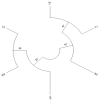Analysis of the Mitochondrial COI Gene and Genetic Diversity of Endangered Goose Breeds
- PMID: 39202396
- PMCID: PMC11353847
- DOI: 10.3390/genes15081037
Analysis of the Mitochondrial COI Gene and Genetic Diversity of Endangered Goose Breeds
Abstract
The mitochondrial cytochrome c oxidase subunit I (COI) genes of six endangered goose breeds (Xupu, Yangjiang, Yan, Wuzong, Baizi, and Lingxian) were sequenced and compared to assess the genetic diversity of endangered goose breeds. By constructing phylogenetic trees and evolutionary maps of genetic relationships, the affinities and degrees of genetic variations among the six different breeds were revealed. A total of 92 polymorphic sites were detected in the 741 bp sequence of the mtDNA COI gene after shear correction, and the GC content of the processed sequence (51.11%) was higher than that of the AT content (48.89%). The polymorphic loci within the populations of five of the six breeds (Xupu, Yangjiang, Yan, Baizi, and Lingxian) were more than 10, the haplotype diversity > 0.5, and the nucleotide diversity (Pi) > 0.005, with the Baizi geese being the exception. A total of 35 haplotypes were detected based on nucleotide variation among sequences, and the goose breed haplotypes showed a central star-shaped dispersion; the FST values were -0.03781 to 0.02645, The greatest genetic differentiation (FST = 0.02645) was observed in Yan and Wuzong breeds. The most frequent genetic exchange (Nm > 15.00) was between the Wuzong and Yangjiang geese. An analysis of molecular variance showed that the population genetic variation mainly came from within the population; the base mismatch differential distribution analysis of the goose breeds and the Tajima's D and Fu's Fs neutral detection of the historical occurrence dynamics of their populations were negative (p > 0.10). The distribution curve of the base mismatches showed a multimodal peak, which indicated that the population tended to be stabilised. These results provide important genetic information for the conservation and management of endangered goose breeds and a scientific basis for the development of effective conservation strategies.
Keywords: COI gene; endangered goose; evolutionary analysis; genetic diversity.
Conflict of interest statement
The authors declare no conflicts of interest.
Figures







Similar articles
-
Analysis of Genetic Diversity and Population Structure of Endemic Endangered Goose (Anser cygnoides) Breeds Based on Mitochondrial CYTB.Animals (Basel). 2024 May 16;14(10):1480. doi: 10.3390/ani14101480. Animals (Basel). 2024. PMID: 38791697 Free PMC article.
-
Genetic Diversity Analysis and Breeding of Geese Based on the Mitochondrial ND6 Gene.Genes (Basel). 2023 Aug 10;14(8):1605. doi: 10.3390/genes14081605. Genes (Basel). 2023. PMID: 37628656 Free PMC article.
-
Whole-genome resequencing reveals the population structure and domestication processes of endemic endangered goose breeds (Anser cygnoides).Poult Sci. 2025 May;104(5):105004. doi: 10.1016/j.psj.2025.105004. Epub 2025 Mar 8. Poult Sci. 2025. PMID: 40088535 Free PMC article.
-
[Population genetic diversity of Culex tritaeniorhynchus in Jining City of Shandong Province based on the mitochondrial cytochrome C oxidase I gene].Zhongguo Xue Xi Chong Bing Fang Zhi Za Zhi. 2024 Oct 24;36(5):466-473. doi: 10.16250/j.32.1915.2024119. Zhongguo Xue Xi Chong Bing Fang Zhi Za Zhi. 2024. PMID: 39623987 Chinese.
-
[Population genetic structure of sandflies in China based on mitochondrial DNA].Zhongguo Xue Xi Chong Bing Fang Zhi Za Zhi. 2025 May 9;37(2):144-151. doi: 10.16250/j.32.1915.2024295. Zhongguo Xue Xi Chong Bing Fang Zhi Za Zhi. 2025. PMID: 40425497 Chinese.
References
-
- Eda M., Itahashi Y., Kikuchi H., Sun G., Hsu K.-H., Gakuhari T., Yoneda M., Jiang L., Yang G., Nakamura S. Multiple lines of evidence of early goose domestication in a 7,000-y-old rice cultivation village in the lower Yangtze River, China. Proc. Natl. Acad. Sci. USA. 2022;119:e2117064119. doi: 10.1073/pnas.2117064119. - DOI - PMC - PubMed
-
- Utnik-Banaś K., Żmija J. The geese market in Poland. Roczniki. 2018;2018:158–163. doi: 10.5604/01.3001.0012.1531. - DOI
MeSH terms
Substances
Grants and funding
LinkOut - more resources
Full Text Sources
Research Materials
Miscellaneous

